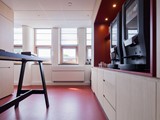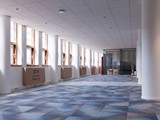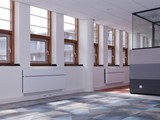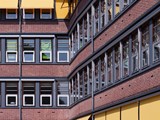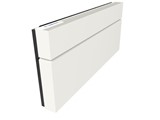Extent 60 ClimaRad Care H1C units
Client Woonstichting Tiwos Tilburg
Consultancy firm Skippon
Aannemer Vermeulen
Installer Feenstra Tiel, BronTechnologie
Date of completion augustus 2019
Reason for office renovation Tiwos
In 2017, Tiwos decided to completely remodel the Stationsstraat office building internally. That year's budget had already been set aside for replacing floor, wall and ceiling finishes and purchasing new central heating boilers. For several reasons, we then made the decision to completely revamp the interior. First, our way of working changed. Teams are increasingly self-managing. To facilitate this organisational change, a new, more flexible office layout was necessary.
Second, office buildings must achieve energy label C starting in 2023. With an F/G label, Tiwos fell far short of that. In our case, the necessary interventions are so radical that waiting until 2023 was not an obvious choice.
Finally, there had been many complaints about climate control and acoustics for years. During the summer, temperatures above 30˚C were recorded in the workplace on hot days. Apart from a few rooms where we already had ClimaRad units installed as a trial, the air refreshment rate also left something to be desired.
Choice ClimaRad
Despite the fact that we already had experience with ClimaRad, we did not see the product as the solution for our office. We were satisfied with the ventilation and heating of the rooms with ClimaRad units, but we missed the possibility of cooling. Initially, we chose a solution with VRF (Variable Refrigerant Flow). But in November 2017, when the design was already final, the office conversion came up by chance in a meeting with ClimaRad. Ralph Liedenbaum and Rick Mathijssen explained the collaboration between ClimaRad and BronTechnology. By pairing ClimaRad units with a soil energy system, cooling was now also possible. We were immediately excited by that option. Because of its much lower energy consumption and lower maintenance costs, the soil energy system combined with the ClimaRad units ultimately proved to be the least expensive to operate. On top of that, the overcapacity of sources allowed us to connect our rented areas above our office and the apartments, with which we form an owners association (VvE in Dutch), to the soil energy system of the future.
Office remodeling progress
In January of this year, we started the office renovation. We renovated in phases, because the office had to continue its operations. In March, we moved into the new second floor. The first floor followed in late June. For now, the ClimaRad Care H1C units are connected to the old central heating system, as the sources are still being excavated. By the end of this year, the units will be connected to the soil energy system. A proper assessment of the system will have to wait a few more months.
By: Lodewijk Verleisdonk, project manager of major maintenance and new construction for housing corporation Woonstichting Tiwos.
By June 2020, the Care units will be connected to the soil energy system. The consulting firm involved recalculated the energy label of Tiwos' building in late 2020, which actually came out to an energy label A.
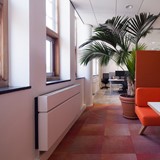
Decentralised ventilation, heating and cooling
The office market is a traditional market in terms of ventilation technology. Yet clients increasingly choose a decentralised system due to of its major advantages including ease of installation, sustainability and energy savings. ClimaRad units ventilate, heat and cool directly through the exterior wall. Air quality and temperature sensors automatically determine the right amount of ventilation air, heat and cold needed. It is an individually controllable plug & play system, ideal for office renovations carried out to meet the new 2023 requirements.
Unlike the use of decentralised units, the construction of central systems requires many ducts, shafts and valves. Construction of these facilities makes up a substantial portion of construction costs. If decentralised systems are used, much of this item can be eliminated. More compact construction is possible, and when renovating existing buildings with limited space, ClimaRad is a simple and efficient solution. If the function of the building changes in the future, the conversion work will be much less invasive. ClimaRad offers a lot of flexibility.
By: ClimaRad BV.
Integration of generation, distribution and consumption point
BRON|TECHNOLOGY & ClimaRad have joined their powerful technical forces to offer a fully integrated climate system as market parties. Traditionally, generation and consumption point are interconnected without intelligent coupling. Precisely linking generation, distribution and consumption points (ClimaRad Care H1C), allowing communication back and forth, creates a ‘smart’ system. All available parameters that determine the desired comfort, including temperature, humidity and CO2, are made available to the EnergyHub that controls central generation and distribution. This allows proactive and future predictive control of comfort. The result: more comfort, better air quality and the lowest possible energy consumption.
By: Hessel Kok, Director and project manager at BRON|TECHNOLOGY.
More information: www.brontechnologie.nl/

